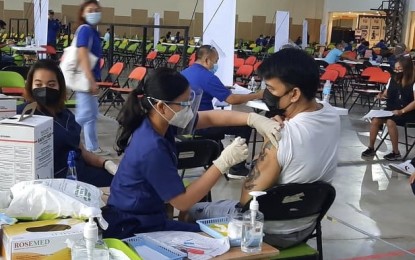
VACCINATION. A nurse administers a vaccine dose to a Cebu City resident at the Project Balik Buhay vaccination center. With the recent rise in Covid-19 cases believed to be a "third wave," DOH-7 officials on Saturday (July 10, 2021) said there is a need to ramp up vaccination to those who directly care for coronavirus patients and the most vulnerable sector in the community. (PNA photo by John Rey Saavedra)
CEBU CITY – With the recent rise in coronavirus disease 2019 (Covid-19) cases in Central Visayas, which health officials considered a “third wave,” the Department of Health (DOH)-Region 7 sees the “need to vaccinate those who will be more affected by infection.”
Dr. Eugenia Mercedes Cañal, the head of the DOH-7 Epidemiology and Surveillance Unit, on Saturday said the region was experiencing a third wave, noting that the epidemic curve shows an upward trend in the last four weeks of their monitoring.
One of the factors that contributed to the increase in Covid-19 cases is the virus itself that “keeps on evolving as it is its nature to mutate, resulting to different variants which increases the virus’ transmissibility,” she said.
Cañal also cited “social mixing” where people gather together for birthdays, weddings, fiesta, and the likes.
“These events drive the transmission because you bring people together without observing the public health measures,” she said.
She also mentioned some people's non-compliance with public health and social measures such as wearing masks, avoiding crowded indoor spaces, staying home, improving ventilation, and washing of hands.
The DOH-7 official also said inequitable and uneven distribution of vaccines could be a reason for the recent surge.
For his part, Dr. Van Philip Baton, DOH-7 vaccination rollout spokesperson, said “So, let’s highlight that vaccines work and we need to vaccinate those who will be more affected by Covid infection: front-line workers who directly care for Covid cases and those who are the most vulnerable in the community”.
He said the people must continue being vigilant in going out for work or leisure, adding that even those who have been vaccinated should also be reminded “to continue practicing minimum public health protocols”.
“We owe it to ourselves to protect those we love with the means we are given,” he said.
Baton believed that vaccine allocation is not an issue but the access to supply, considering “the limited vaccine supply (that) has resulted in the most exposed and most vulnerable as being prioritized.”
However, he said some of those who need it the most take time before getting vaccinated.
The goal of vaccination is to protect the limited resources such as limited beds and limited manpower, he said, reiterating that vaccines have been shown to have been very effective in preventing symptomatic Covid-19 cases that result in hospital admissions and prolonged hospital stay.
“So the increasing cases should emphasize the need to protect those who need it immediately. As we have seen, the number of senior citizens in the region has not reached even 25 percent after more than two months of rolling out vaccination for them,” Baton pointed out.
Cañal is yet to brief the media as to when the third wave started and what the affected areas of Central Visayas are.
The DOH-7 bulletin released Saturday night showed 114 new Covid-19 cases in this capital city; 39 in Lapu-Lapu City; 28 in Mandaue City; 108 in Cebu province; 76 in Bohol; 45 in Negros Oriental; and nine in Siquijor.
Central Visayas region now has a total of 8,241 active cases, with Negros Oriental having the most at 3,684 followed by Bohol at 1,934 and Cebu City at 1,077.
The province of Cebu has 807 active cases, the two independent cities of Lapu-Lapu and Mandaue have 385 and 325, respectively, while Siquijor has 29. (PNA)
